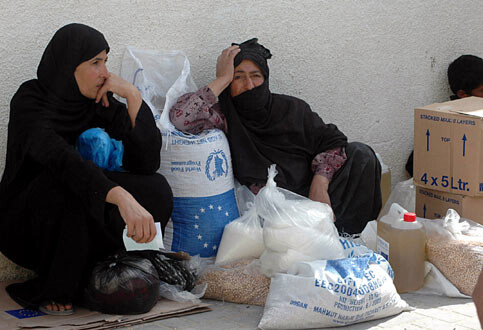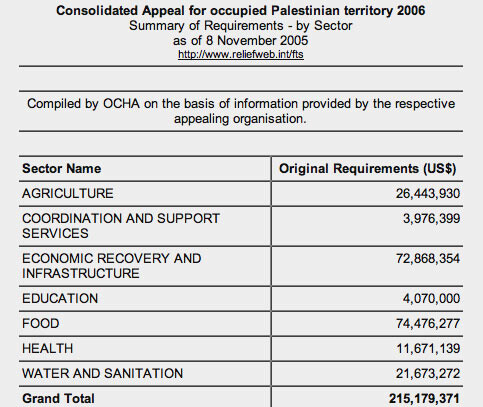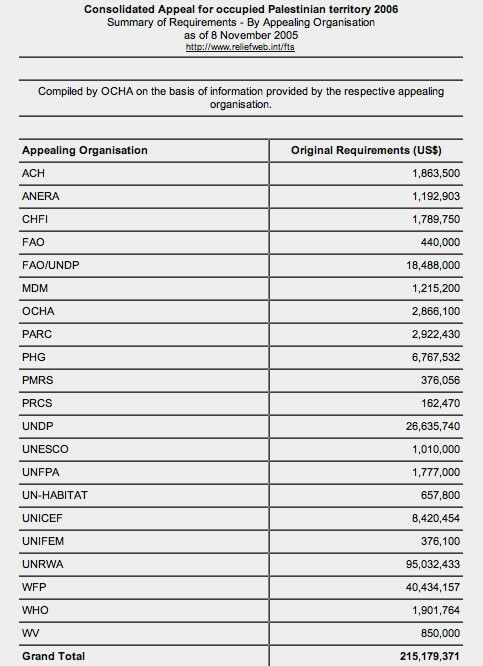UN Office for the Coordination of Humanitarian Affairs 30 November 2005

Palestinians receive the monthly ration aids from the UNRWA agency, as assistance for the Palestinian refugees in Rafah governorate to the south of Gaza Strip October 25, 2005. (MAANnews/Hatem Omar)
For the fourth consecutive year humanitarian agencies are appealing to donors for funding for the occupied Palestinian territory (oPt). The unfortunate need for yet another appeal stems from a largely unchanged humanitarian situation. Poverty rates have increased in 2005 compared to 2004, largely because the quality of work is lower and households’ coping mechanisms are increasingly fragile.
The West Bank and Gaza Strip (WBGS) remain strangulated by an inability to freely cross borders to potential markets and move within the West Bank. The Israeli Government has stated that these measures are necessary to prevent militant attacks on Israeli citizens. Unless these restrictions are eased the prospect of indigenous Palestinian economic growth is dim. As the World Bank has noted on many occasions, increased donor spending within a policy environment of restricted access will have limited impact on alleviating Palestinian poverty.
Until improvements occur the need for humanitarian assistance remains crucial. Coping mechanisms - such as using remaining savings, going into debt with neighbours and relying increasingly on credit - are unsustainable. The fact that people are increasingly relying on them reinforces the importance of humanitarian assistance as a form of income support to allow people to concentrate resources on other essential needs. Cutting back on assistance will put extreme stress on these already-stretched strategies and increase poverty.
This humanitarian picture has persisted despite positive political momentum over the past year. The election of President Abbas and Israel’s disengagement from settlements in the Gaza Strip and northern West Bank has infused momentum into a sluggish peace process. There has also been some positive easing of Palestinian movement in the West Bank in the first half of 2005. The problem is that as yet none of these developments have made a dent in the key humanitarian indicators of the current crisis.
Nevertheless efforts are underway to move into a recovery and eventually, development mode of assistance. The appointment of James Wolfensohn as the Special Envoy to the Quartet on Disengagement has resulted in a Rapid Action Programme (RAP) and the possibility of increased donor funding of up to US$ 3 billion a year to the recovery effort over a period of three years to support the Palestinian Medium-term Development Plan (MTDP). He has also been intensively negotiating for improvements in Palestinian access.
The Palestinian Authority (PA) initiated its first three year MTDP for 2005-2007 which has provided a basic framework for the 2006 CAP ensured that humanitarian projects are complementary with its initiatives. The CAP has also been drafted alongside the preparation of a Common Assessment. This is the forerunner of the United Nations (UN) Development Framework — a more comprehensive planning structure — that also signals a readiness to return to a longer-term approach.
These initiatives have enabled UN to shift more transitional projects such as infrastructure rehabilitation — out of the CAP in contrast to previous years. As a result, the CAP this year is tightly focused on life-saving humanitarian needs such as: improving availability of food; emergency employment for vulnerable households; enhancing access to health services and improving awareness of the root causes of the humanitarian situation. The total request to donors in 2006 is US$ 215 million down from US$ 302 million in 2005.
Targeting the most vulnerable has been greatly strengthened by the adoption of a new ‘Needs Analysis Framework’. This approach, adopted by all agencies, employs a ‘bottom-up’ approach that rigorously measures the most vulnerable.
The CAP for 2006, therefore, has 64 initiatives in 1) coordination and support services; 2) education; 3) emergency job creation and cash assistance; 4) food security (including agriculture); 5) health (including psycho-social support); 6) water and sanitation.
However, the vexed dilemma noted in all other previous CAPs remains. As the occupying power, Israel has the primary responsibility under the Fourth Geneva Convention to meet the needs of those it occupies. The international community appears increasingly willing to shoulder Israel’s burden and provide assistance directly to Palestinians.

The list of projects and the figures for their funding requirements in this document are a snapshot as of 8 November 2005. For continuously updated information on projects, funding requirements, and contributions to date, visit the Financial Tracking Service.

The list of projects and the figures for their funding requirements in this document are a snapshot as of 8 November 2005. For continuously updated information on projects, funding requirements, and contributions to date, visit the Financial Tracking Service.
YEAR IN REVIEW: MAJOR CONTEXT DEVELOPMENTS IN 2005
The political momentum witnessed since the beginning of 2005 provided a welcome turning point in a previously sluggish political environment. The death of President Arafat in November 2004 was followed by the election of President Abbas who was considered by the Israelis and the international community as a more acceptable negotiating partner than his predecessor. The Sharm al Sheik leaders’ summit in February 2005, after which a ‘period of calm’ was announced by Palestinian militant groups and cessation of military activity by Israel, led to relative quiet in Gaza compared with the frequent clashes and heavy casualties that characterised 2004. The disengagement (albeit unilateral) of settlers and military infrastructure from within the Gaza Strip and parts of the northern West Bank also fed the prevailing sense of new opportunities for peace in the seemingly interminable grind of the Palestinian-Israeli conflict.
In parallel, tentative efforts are underway towards a recovery and eventually, development style approach to assistance. The PA initiated its first three year MTDP for 2005-2007. The arrival of James Wolfensohn as Special Envoy to the Quartet on Gaza Disengagement resulted in the pledging by donors of up to US$ three billion to the recovery effort over a period of three years. His arrival has breathed new life into Palestinian access issues. These included easing Palestinian movement from Gaza into Egypt, the linkage of Gaza and the West Bank, the passage of goods across the borders with Israel and the easing of Palestinian movement around the West Bank. The instigation by the UN of the Common Assessment “lite” also signalled its readiness to take a longer-term approach to the region. After five years during which a humanitarian style response was predominant, these developments appear to suggest that the oPt is at a new juncture.
From a humanitarian perspective, while progress on the political front is understood as the only means to ultimately alleviate poverty and suffering, as yet there has been sign of humanitarian improvement. Poverty has climbed to 64% and unemployment, at 27%, is almost three times what it was in 2000. The key reason is that root causes remain. Israel’s permit and closure system regulating movement of Palestinians and goods, which the Israeli Government has stated are essential for the security of its citizens, remains fundamentally unchanged.
Without significant changes in internal and external closures, the humanitarian situation in the oPt will not improve.1 Meanwhile the other structural constraints related to Israel’s occupation, the ongoing settlement and bypass road construction, and control over water resources has continued. In response, the CAP 2005 focused on four key areas: impoverishment, fragmentation of socio-economic life, acute crisis areas and protection of civilians.
FINANCIAL OVERVIEW
According to information provided by donors and appealing organisations and compiled by OCHA’s Financial Tracking Service (as of November 2005), the CAP oPt has been funded at a rate of 59% i.e. a total of approximately US$ 177 million has been received, with a potential addition of US$ 10,261,905 pledged. If pledges were realised, it would bring the overall funding level at 62%.
To download the full original appeal (PDF) click here and for the full list of projects (PDF) here.
Related Links